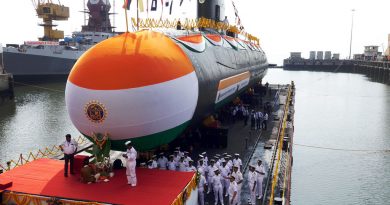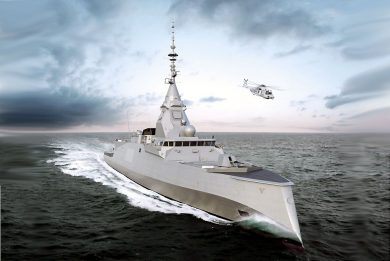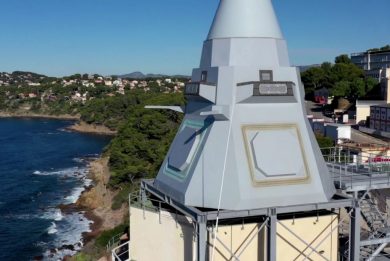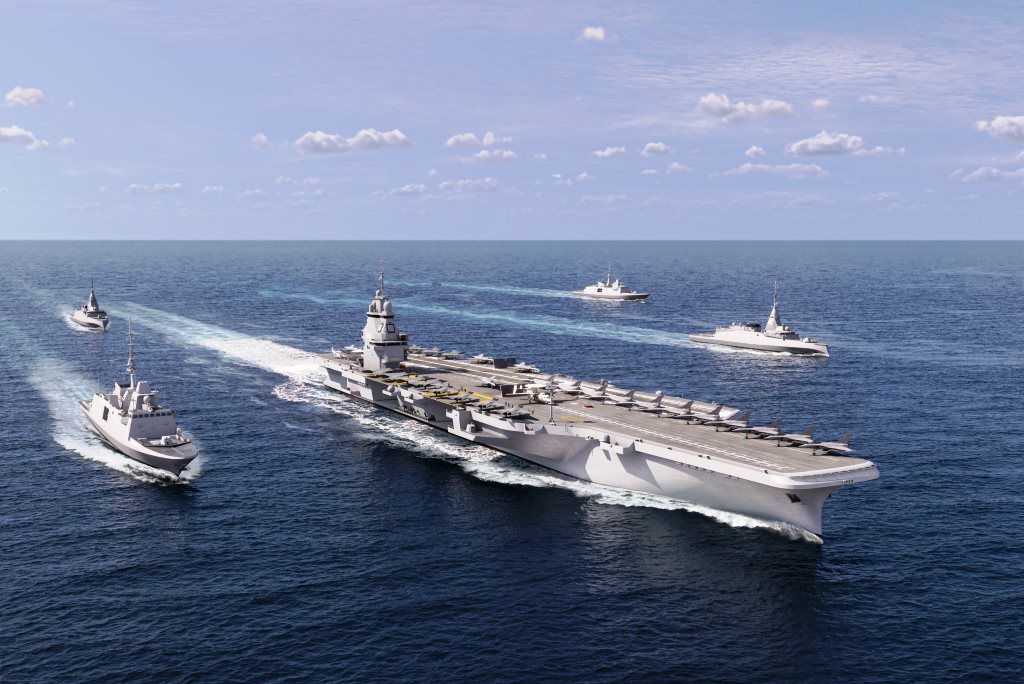
French Navy new generation aircraft carrier design detailed
The latest design of the French Navy new generation aircraft carrier (PA NG, Porte-Avions Nouvelle Génération) was unveiled by the French Armament General Directorate (DGA) during the Euronaval 2022 exhibition, EDR On-Line having acquired later further details from the DGA.
Launched by French President Emmanuel Macron in December 2020, the PA NG programme is devoted to the design, construction and delivery of a new nuclear-powered aircraft carrier intended to replace the current flagship of the Marine Nationale, the Charles de Gaulle, around 2038. Taking over the current aircraft carrier missions in an evolving and threatening environment, the PA NG will enable French Forces to provide power projection, sea control, air support to joint operations, maritime component command (alone or in coalition) contribution to intelligence, and at sea deterrence.
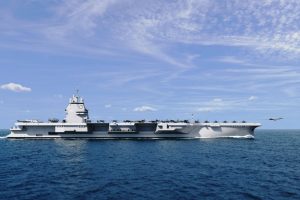
The new platform is being developed and will be built by the MO Porte-Avions, the joint company between Naval Group (65%) and Chantiers de l’Atlantique (35%), and TechnicAtome, which are in charge of the overall program management under the contracting authority of the DGA, with the CEA, the Atomic Energy Commission, for nuclear reactors. TechnicAtome is the prime contractor for the nuclear reactors while the MO Porte-Avions joint company is prime contractor for the whole vessel.
The latest technical specifications provided by the DGA programme director, which name has been withheld for security reasons, unveil a platform with a full load displacement of approximately 75,000 tonnes, an overall length and width of respectively 310 meters (305 meters at waterline) and 85 meters (39 meters at waterline) and a max draught of 10.9 meters. With the progress of industrial studies, the DGA made the choice of energy conversion and electrical distribution architectures, and confirmed the three propellers configuration. The propulsion package is therefore based on two K22 nuclear steam supply systems (NSSS) providing 220 MW each, with steam turbines on the two shaft lines. These produce electricity power for the whole ship, including the propulsion, ensuring a maximum speed of 27 knots. The new aircraft carrier will have accommodations for 2,000 personnel, like Charles de Gaulle, including the air wing crews and maintainers, and fleet headquarters personnel.
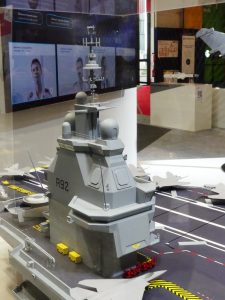
The design of the flight deck and the carrier island has significantly evolved since the initial layout unveiled in 2020. “Space and volume margins have been considered into the flight deck, hangar and internal spaces, to welcome bigger aircraft than the Rafale M,” said the programme manager referring to the New Generation Fighter (NGF). This is at the core of the Future Combat Air System (FCAS)/Système de Combat Aérien Futur (SCAF), which also includes the Remote Carrier (RC) and the air combat cloud (AAC) networked battlespace. “Although changes could be introduced from today to 2025, when the development and production phase is planned to be launched, the overall design is quite well defined,” he told EDR On-Line. The DGA is carrying on stability and manoeuvrability tests and trials with a 10 meters long and 3 tonnes heavy platform model on the Lac de Castillon (Alpes-de-Haute Provence) to validate its performances, which have been so far very good, according to the same DGA representative. The DGA is also determining the specification of active internal and external systems to ensure the stability of the platform in all conditions to maximize aircraft operations availability.
With a surface of approximately 17,000 m2, the flight deck layout has been optimised for the operations with the 90 meters General Atomics electromagnetic aircraft launching system (EMALS) and advanced arresting gear (AAG) as used on new generation US Navy aircraft carriers, as well as to reduce the turn-around and launch and recovery cycles with the embarked air wing of around 30 New Generation Fighter (NGF) and Rafale M, two Northrop Grumman E-2D Hawkeye and five to six NH 90 helicopters. The flight deck currently presents two EMALS, one on the forward area of the deck and the other on the angled flight deck, the latter having slightly rotated externally to better manage flight operations. A third catapult option is also being studied by the DGA, to be installed side-by-side with the forward positioned one.
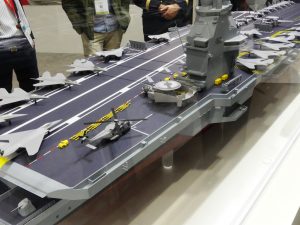
The DGA and French Navy team has also further evolved Naval Group work on an optimised flight deck operations, with an extreme stern starboard side area dedicated to the ‘Pedro’ NH90 Caiman search and rescue helicopter, which is always available during launch and recovery as well as during vertrep operations, while a quick turn-around and maintenance area dedicated to the future E-2D Advanced Hawkeye has been identified just behind the island. The redesign also involved the hangar, ammunition storage, and connecting secondary elevators for munitions and other duties, alongside refuelling and rearming external and internal areas, to speed up operations with the embarked combat aircraft.
According to a DGA presentation, in addition to the carrier strike group wing including the NGF or SCAF, the Rafale Marine and the E-2D, alongside the NH90 Caiman, the PA NG can accommodate H-160M Guépard Marine and EC-725 rotary-wing aircraft, and is planned to be compatible and able to accommodate several US Navy aircraft such as the F-35C, the CMV-22 and the F-18, alongside CH-47 helicopters.
The island saw a significant evolution both in terms of flight control managing and sensors accommodation. According to the programme manager, the configuration presented at Euronaval 2022 illustrates actual studies to identify functional and physical constraints of all eligible systems, but may evolve significantly in further years. The flight control station and the bridge area were completely redesigned with better situational awareness and management of both air operations and ship conduction. Thanks to the last step of an exhaustive functional analysis, the above cone design for accommodating sensors and communications has been deleted to make space for a more conventional infrastructure that combines the four fixed faces of the Thales Sea Fire AESA 3D multifunction radar as well as all required satellite and conventional communications radomes and antennas. The top mast also includes RESM and CESM antennas, while two Safran Paseo XLR turrets are installed to offer a 360 degrees coverage.
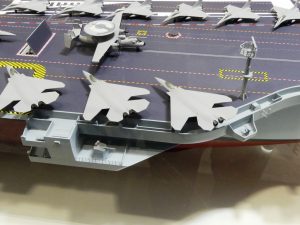
In addition to long-range acoustic devices (LRADs), the latest platform’s defence package includes four Nexter/Thales RAPIDFire 40 mm gun mounts with their embedded EO fire control director, three MBDA SIMBAD RC twin launchers for Mistral missiles, as well as anti-air warfare and anti-torpedo decoy launchers. In the latter case they consist in the Naval Group pneumatic launcher for the CANTO V decoy. The longer range air defence protection is planned to be assured by at least two 8-cell vertical launching systems (VLSs) for Aster missiles, with embedded capabilities to evolve during the platform life time. The DGA is still considering a range of options regarding the configuration of the defence weapon package, according to the DGA PA NG programme manager. The Agency and the French Navy have however incorporated design growth margins in term of spaces and energy power for the installation of DEWS (Direct Energy Weapon Systems) that are expected to benefit from the available energy power thanks to the aircraft carrier nuclear propulsion.
Battlespace connectivity is ensured by RIFAN (Réseau IP de force aéronavale), SYRACUSE satellite communications, COMCEPT (besoins complémentaires en communications d’élongation de projection et de théâtre), CONTACT (Communications Numerisées Tactique et de Théatre) and MELCHIOR (Moyen d’élongation pour les communications HF interarmées et OTAN en réseau) communications networks, Link 16 and 22 tactical data links, while electronic warfare suite could include Thales RESM and CESM. The latest aircraft carrier island design also features optical communication systems.
The shipbuilding, outfitting and delivery programme timeline
“The PA NG programme is currently in the risk mitigation and innovation studies,” the DGA PA NG programme manager told the media. Launched at the beginning of 2021, these are expected to be concluded at the end of 2023, while preliminary design studies were launched in Q1 2021 and set to end in Q1 2023. These will be followed by the programme definition phase to last until late 2025, when the System Functional Review is planned to take place. Including feasibility and definition studies, the current phase is devoted to optimise the ship and enable its production, with main focus on general architecture and arrangement, main performance assessment and preliminary design of major systems (propulsion, flight deck, etc.). At the end of 2025 is set the decision for the launching of the development and production phase, which will llast about eleven years period.
As anticipated, the MO Porte-Avions joint company is responsible for shipbuilding while TechnicAtome takes care of the nuclear reactor. Naval Group is in charge of the assembly of the nuclear reactors and auxiliary capacities, the production of the main reactors components, the whole warship architecture, aviation facilities and combat systems, alongside power conversion systems. The Chantiers de l’Atlantique is in charge of the platform shipbuilding, including life and hospital, propulsion, ventilation, fluids, manoeuvring devices, etc. and of the ship assembly.
As the fuelling of the nuclear core and the first power up of the reactor are planned in Toulon as the Chantiers de l’Atlantique is only a conventional shipyard, the transfer is to be taken on vessel’s own power. However as the nuclear propulsion system couldn’t be operational yet, the platform is expected to be equipped with a temporary and large package of diesel generators on removable installations on the flight deck or eventually inside the hangar. This solution would see these diesel generators providing power to the platform electric motors, allowing its transfer to the facilities in the Mediterranean, and could also be used for some preliminary electric tests of the platform and flight deck facilities, since the all-electric architecture of the ship allows it.
First sea going on nuclear propulsion from Toulon is planned in early 2036, while acceptance by French DGA is planned for late 2036 and commissioning by late 2037-early 2038. Many DGA centres of expertise and testing are involved in the PA NG programme, including DGA Hydrodynamics, Naval Systems, Land Systems, Aeronautical Systems, Information Superiority, Flight Testing, Missiles Testing and Engineering and Integration.
Images courtesy MO Porte Avions (Naval Group, Chantiers de l’Atlantique, TechnicAtome), photos courtesy L. Peruzzi

